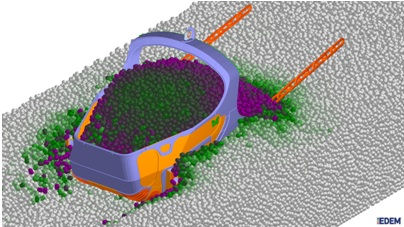Latest News
May 14, 2014
DEM Solutions Ltd. (Edinburgh, Scotland) has released version 2.6 of its EDEM suite of its DEM (discrete element method) software for simulating and analyzing the complex motions and interactions of large amounts of particulate materials encountered during the design, prototyping and optimization of equipment that handles and processes bulk solid materials. Version 2.6, says the company, offers users 40 additional and improved features that increase its usability, reliability, productivity and connectivity with other CAE tools.
The EDEM software platform is intended to provide engineers designing and optimizing bulk material handling equipment such as diggers, buckets, scrapers and bulldozers with the means to reduce dependency on physical prototyping while shortening design cycles. It can simulate and analyze the behavior of many forms of bulk materials, including coal, pellets and tablets. When used with other CAE tools such as CFD (computational fluid dynamics) and MBD (multi-body dynamics), EDEM, says the developer, can provide engineers designing and optimizing equipment with insights and information on the forces and loading on equipment caused by the interaction with a bulk material.
Three components — EDEM Creator, EDEM Simulator and EDEM Analyst — make up the core of the EDEM software platform.
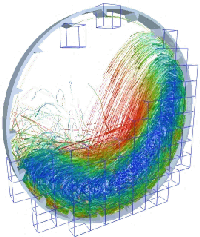 EDEM simulation of a ball mill, showing vectors colored by velocity and data analysis bins that can rotate with the mill. Image courtesy of DEM Solutions Ltd.
EDEM simulation of a ball mill, showing vectors colored by velocity and data analysis bins that can rotate with the mill. Image courtesy of DEM Solutions Ltd.The EDEM Creator pre-processor has capabilities for importing CAD models of equipment, templates of representative model particle shapes and particle-scale physics models. With it, engineers can store material parameters of a bulk material being simulated such as model particle shape and size distribution as well as mechanical, material and other physical properties in a library, allowing them to build a collection specific to an organization’s processes. CAD models of real particles can also be imported to obtain an accurate representation of their shape.
The EDEM Simulator solver performs the particle-scale physics calculations that determine bulk particle dynamics. Parallelized for optimal compute efficiency on multi-core computers, EDEM Simulator, explains DEM Solutions, is based on a sphere-element particle primitive from which multi-element particles can be generated to represent non-spherical particles, which, the developer adds, is the fastest method of simulating non-spherical particles.
The EDEM Analyst post-processor is described as offering an extensive set of data analysis and 3D visualization tools. Information from the bulk system can be extracted and viewed with fast image rendering and video generation. Additional capabilities include data mining and export for further analysis.
DEM Solutions reports that in version 2.6 enhancements have been made to the EDEM coupling interface, which provides the structure for coupling EDEM with other CAE tools such as MBD and CFD. Version 2.6 introduces a new functionality for sharing data with FEA (finite element analysis) systems. This new facility, reports the company, extends existing FEA and MBD analyses to include the effects of interaction of bulk materials. This, says the developer, provides a major advantage for engineers designing and optimizing equipment handling bulk materials, including ores, soil, grains and powders.
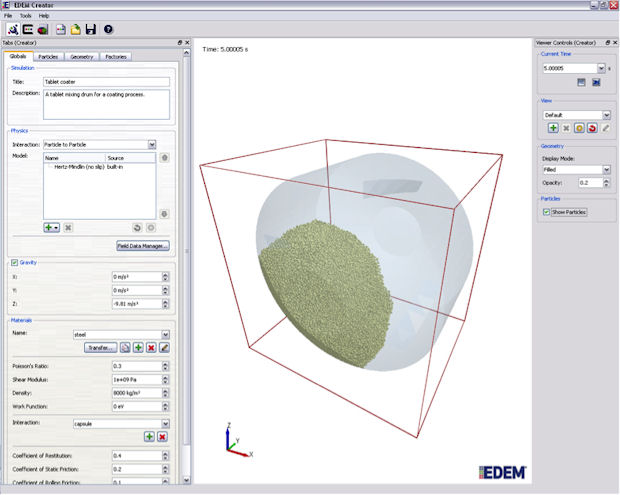 The EDEM Creator user interface features full, interactive 3D visualization. Image courtesy of DEM Solutions Ltd.
The EDEM Creator user interface features full, interactive 3D visualization. Image courtesy of DEM Solutions Ltd.“Our strategy is to complement other CAE tools by providing robust integration of EDEM simulation,” said Richard LaRoche, DEM Solutions VP of Engineering & Software Development in a press statement. “Our customers who design equipment for handling bulk material have suffered from an incomplete view of how the equipment will perform. Over the past several years we have witnessed the benefits of EDEM integration in generating new solutions combining particle and machine dynamics to result in powerful, new insights into the machine-material interaction. The new release extends our ability to address this challenge.”
Usability enhancements in version 2.6 include the ability for users to make use of the EDEM Creator preprocessor and the EDEM Analyst post-processor environments at the same time as a simulation is running. As well, DEM Solutions has implemented a new FEA export function that allows users to export force data from EDEM to directly into ANSYS Mechanical, reducing the amount of postprocessing required. This function automatically structures force data into a text file format that can be imported into ANSYS where the force data can be interpolated to the mesh and complete the analysis.
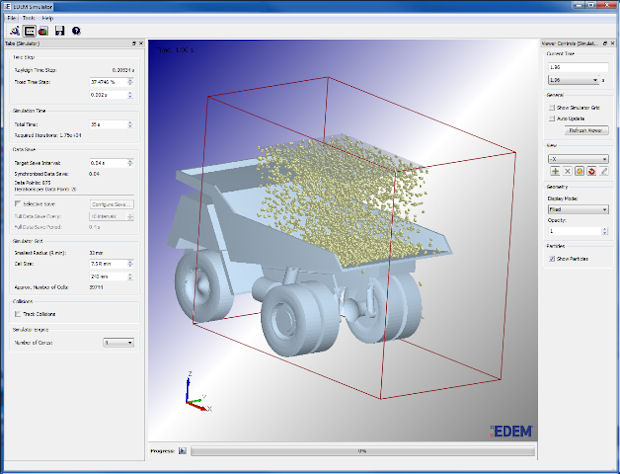 Simulations can be conducted from within the easy to use GUI or via a command line interface. Image courtesy of DEM Solutions Ltd.
Simulations can be conducted from within the easy to use GUI or via a command line interface. Image courtesy of DEM Solutions Ltd.DEM Solutions says that EDEM 2.6 now provides greater insight into the potential for equipment wear by allowing engineers to visualize the energy imparted through material contact directly on the equipment surface. Three new wear models are now available as standard. The wear models can display energy imparted both tangentially and normal to the surface, which can help identify if an area suffers “impact” type strikes or more “abrasive” wear. An Archard wear model is included for calibrating a model to give an estimation of wear depth.
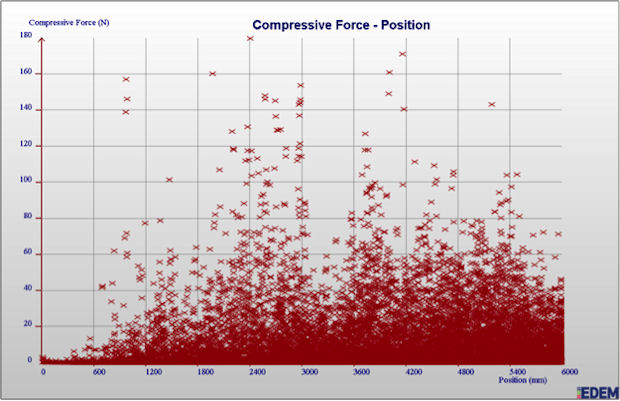 EDEM Analyst allows you to plot results as histograms, line charts and scatter plots. Image courtesy of DEM Solutions Ltd.
EDEM Analyst allows you to plot results as histograms, line charts and scatter plots. Image courtesy of DEM Solutions Ltd.Other new features include a Particle Size Distribution tool for easy input of non-uniform distribution profile, support for Red Hat Linux 6.0 and a more flexible licensing structure. EDEM runs on standard shared memory parallel computers with either Windows or Linux operating systems. The developer also offers optional add-on modules for EDEM, including an API (applications programming interface). A full-featured version of EDEM with extended capabilities is available for academic research through the company’s EDEM Academic Partner Program.
For further information about EDEM version 2.6, go to DEM Solutions.
See how EDEM is deployed in various industries.
See why DE’s Editors selected EDEM 2.6 as their Pick of the Week.
Sources: Press materials received from the company and additional information gleaned from the company’s website.
Subscribe to our FREE magazine, FREE email newsletters or both!
Latest News
About the Author
Anthony J. Lockwood is Digital Engineering’s founding editor. He is now retired. Contact him via [email protected].
Follow DE






